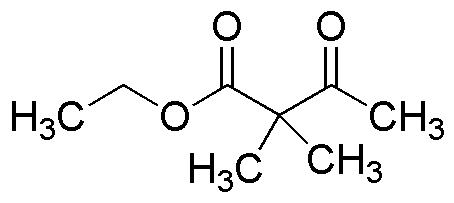2,2-Dimethyl-3-oxo-butyric acid ethyl ester is widely utilized in research focused on:
- Flavoring and Fragrance Industry: This compound is used as a flavoring agent in food products and beverages, providing a pleasant fruity aroma that enhances consumer appeal.
- Pharmaceuticals: It serves as an intermediate in the synthesis of various pharmaceutical compounds, aiding in the development of new medications with improved efficacy.
- Agricultural Chemicals: The compound is employed in the formulation of agrochemicals, contributing to the development of effective pesticides and herbicides that improve crop yield.
- Cosmetics: It is utilized in cosmetic formulations for its skin-conditioning properties, enhancing the texture and feel of personal care products.
- Polymer Production: This chemical acts as a building block in the production of specialty polymers, which are used in various applications, including coatings and adhesives, offering superior performance compared to traditional materials.
General Information
Properties
Safety and Regulations
Applications
2,2-Dimethyl-3-oxo-butyric acid ethyl ester is widely utilized in research focused on:
- Flavoring and Fragrance Industry: This compound is used as a flavoring agent in food products and beverages, providing a pleasant fruity aroma that enhances consumer appeal.
- Pharmaceuticals: It serves as an intermediate in the synthesis of various pharmaceutical compounds, aiding in the development of new medications with improved efficacy.
- Agricultural Chemicals: The compound is employed in the formulation of agrochemicals, contributing to the development of effective pesticides and herbicides that improve crop yield.
- Cosmetics: It is utilized in cosmetic formulations for its skin-conditioning properties, enhancing the texture and feel of personal care products.
- Polymer Production: This chemical acts as a building block in the production of specialty polymers, which are used in various applications, including coatings and adhesives, offering superior performance compared to traditional materials.
Documents
Safety Data Sheets (SDS)
The SDS provides comprehensive safety information on handling, storage, and disposal of the product.
Product Specification (PS)
The PS provides a comprehensive breakdown of the product’s properties, including chemical composition, physical state, purity, and storage requirements. It also details acceptable quality ranges and the product's intended applications.
Certificates of Analysis (COA)
Search for Certificates of Analysis (COA) by entering the products Lot Number. Lot and Batch Numbers can be found on a product’s label following the words ‘Lot’ or ‘Batch’.
*Catalog Number
*Lot Number
Certificates Of Origin (COO)
This COO confirms the country where the product was manufactured, and also details the materials and components used in it and whether it is derived from natural, synthetic, or other specific sources. This certificate may be required for customs, trade, and regulatory compliance.
*Catalog Number
*Lot Number
Safety Data Sheets (SDS)
The SDS provides comprehensive safety information on handling, storage, and disposal of the product.
DownloadProduct Specification (PS)
The PS provides a comprehensive breakdown of the product’s properties, including chemical composition, physical state, purity, and storage requirements. It also details acceptable quality ranges and the product's intended applications.
DownloadCertificates of Analysis (COA)
Search for Certificates of Analysis (COA) by entering the products Lot Number. Lot and Batch Numbers can be found on a product’s label following the words ‘Lot’ or ‘Batch’.
*Catalog Number
*Lot Number
Certificates Of Origin (COO)
This COO confirms the country where the product was manufactured, and also details the materials and components used in it and whether it is derived from natural, synthetic, or other specific sources. This certificate may be required for customs, trade, and regulatory compliance.


